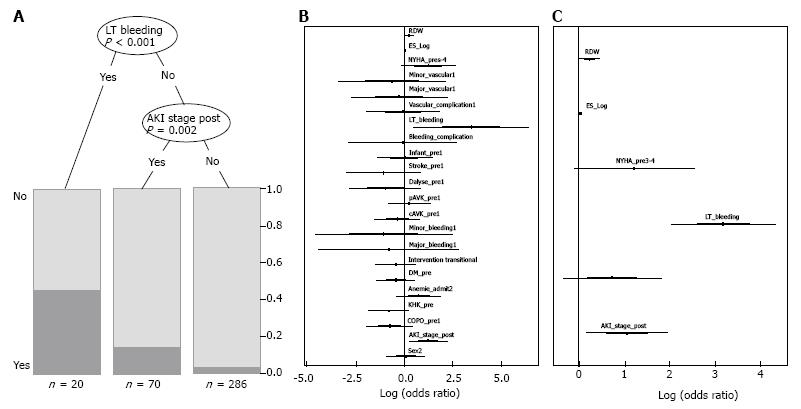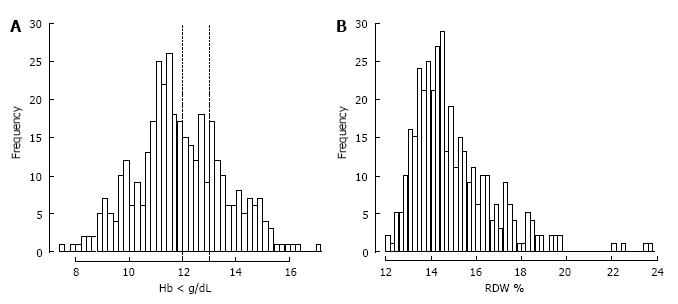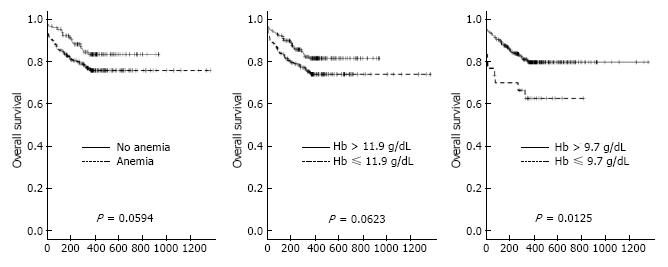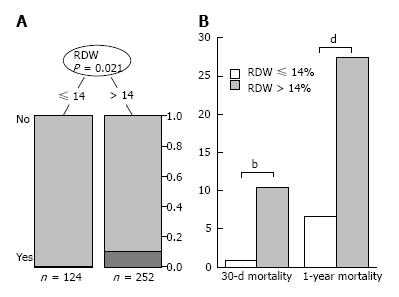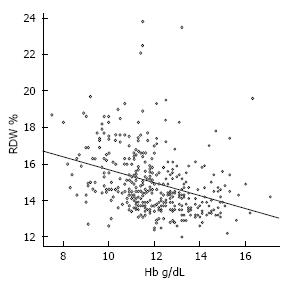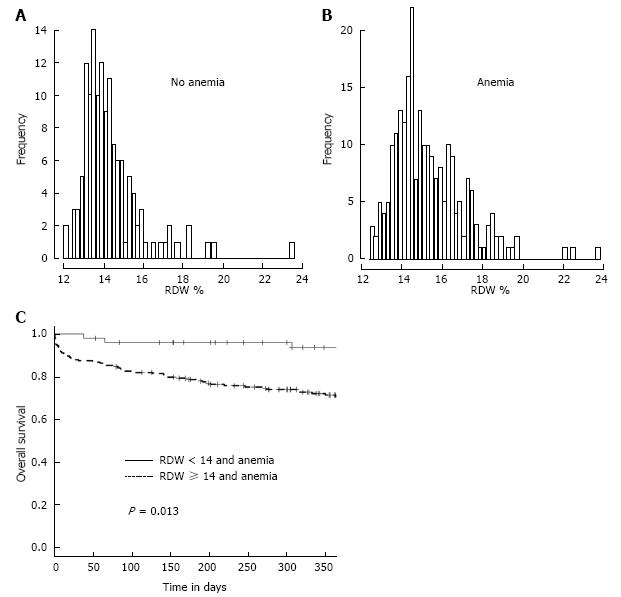Copyright
©The Author(s) 2016.
World J Cardiol. Feb 26, 2016; 8(2): 220-230
Published online Feb 26, 2016. doi: 10.4330/wjc.v8.i2.220
Published online Feb 26, 2016. doi: 10.4330/wjc.v8.i2.220
Figure 1 Regression analysis for risk factors associated with 30-d mortality.
A: Results from the classification tree with significant node-splits and distribution of patients. Life-threatening bleeding (P < 0.001) and acute kidney injury (P = 0.002) were found to be statistically relevant risk factors for 30-d mortality; B: Logistic regression with all covariables which were supposed to be associated with 30-d mortality. Forest plot with odds ratios and 95% confidence intervals (logarithmic scale); C: Logistic regression with the best selected covariables using AIC. Life-threatening bleeding (P < 0.001), acute kidney injury post procedure (P = 0.018) and RDW (P = 0.044) were found to be statistically relevant risk factors for 30-dmortality. AIC: Akaike information criterion; AKI stage post: Acute kidney injury stage I-III post; CAD: Coronary artery disease; Cavk: Cerebroarterial vascular disease; COPD: Chronic obstructive pulmonary disease; DM: Diabetes mellitus; ES log: Logistic EuroSCORE; LT bleeding: Life-threatening bleeding; NYHA: New York Heart Association; pAVK: Peripheral vascular disease; RDW: Red cell distribution width.
Figure 2 Regression analysis for risk factors associated with anemia.
A: Classification tree with significant node-splits and distribution of patients with anemia. A creatinine > 1.1 mg/dL (P < 0.001) and age > 83 (P = 0.027) were found to be statistically relevant risk factors for anemia; B: Logistic regression with all covariables which were supposed to be associated with anemia. Forest plot with odds ratios and 95%CI (logarithmic scale); C: Logistic regression with the best selected covariables using AIC. A creatinine > 1.1 mg/dL (P < 0.001) and age > 83 (P = 0.001) were found to be statistically relevant risk factors for anemia. a: Years; AIC: Akaike information criterion; CAD: Coronary artery disease; CKD: Chronic kidney disease; Crea pre: Creatinine (mg/dL) preoperative; DM: Diabetes mellitus; LVEF: Left ventricular ejection fraction (%).
Figure 3 Histogram of the distribution of hemoglobin and red cell distribution width levels.
A: Histogram of the distribution of hemoglobin levels. Vertical lines at 12 g/dL and 13 g/dL for population based cut-off points for women and men according to WHO definition of anemia; B: Histogram of RDW levels. Hb: Hemoglobin; RDW: Red cell distribution width.
Figure 4 Anemia and one-year mortality.
A: One-year survival curves of patients with and without anemia (P = 0.0594); B: One-year survival curves of patients grouped according to their hemoglobin level above or below mean Hb level of 11.9 g/dL; C: One-year survival curves of patients grouped according to their hemoglobin level above or below cut-off point of 9.7 g/dL.
Figure 5 Red cell distribution width and mortality.
A: Classification tree for 30-d mortality with significant node split at RDW 14% (P = 0.021); B: Thirty-day (P < 0.01) and one-year mortality (P < 0.001) of patients grouped according to the presence of RDW ≤ 14% or > 14%. RDW: Red cell distribution width.
Figure 6 Correlation of hemoglobin with red cell distribution width.
RDW and hemoglobin showed a significantly negative correlation (-0.36; 95%CI: -0.45, -0.27; P < 0.001). Hb: Hemoglobin; RDW: Red cell distribution width.
Figure 7 Distribution of red cell distribution width and survival of anemic patients according to their red cell distribution width.
A: Distribution of RDW in patients without anemia; B: Distribution of RDW in patients with anemia; C: Survival curves of patients with anemia grouped to their RDW above or below cut off point of 14% (P = 0.013). RDW: Red cell distribution width.
- Citation: Hellhammer K, Zeus T, Verde PE, Veulemanns V, Kahlstadt L, Wolff G, Erkens R, Westenfeld R, Navarese EP, Merx MW, Rassaf T, Kelm M. Red cell distribution width in anemic patients undergoing transcatheter aortic valve implantation. World J Cardiol 2016; 8(2): 220-230
- URL: https://www.wjgnet.com/1949-8462/full/v8/i2/220.htm
- DOI: https://dx.doi.org/10.4330/wjc.v8.i2.220









